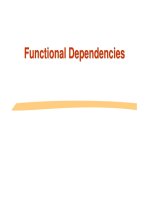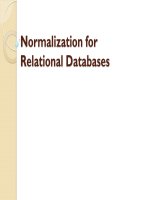Distributed Database Management Systems: Lecture 30
Bạn đang xem bản rút gọn của tài liệu. Xem và tải ngay bản đầy đủ của tài liệu tại đây (82.08 KB, 28 trang )
Distributed Database
Management Systems
Lecture 30
In the previous lecture
• Locking based CC
• Timestamp ordering
based CC
• Concluded TM.
In this Lecture
• Basic Concepts of Query
Optimization
• QP in centralized and
Distributed DBs.
Introduction
• SQL one of the success
factors of RDBMS
• Query processor
transforms complex
queries into concise and
simple ones
• Query processing is
critical performance
issue
• QP a complex
problem specially in
DDBS environment
• Main function of QP is to
transform an SQL query
into equivalent relational
algebra one (low level
language)
• Transformation must
achieve correctness and
efficiency
• Correctness is
straightforward since
rules exist
• An SQL query can
have many equivalents
in R Algebra
• Considering the tables
• EMP(eNo, eName, title)
• ASG(eNo, pNo, resp, dur)
• PROJ(pNo, pName,
budget, loc)
• Query: Get the names of
employees who are
managing a project
• SELECT eName
FROM EMP, ASG
WHERE EMP.eNo =
ASG.eNo
AND resp = ‘Manager’
( resp=‘Manager’ ^ EMP.eNo =
ASG.eNo) (EMPxASG)
eName
(EMP ⋈ ( resp=‘Manager’
(ASG)))
• Obviously second one needs
less computing resources
since avoids Cartesian product
eName
• Centralized QP is to
choose best query
execution plan
• Distributed is more
complex; it also involves
the selection of site to
execute query
• Same query in DDBS
• Suppose EMP and ASG
are HF as
• EMP1 = eNo ≤ ‘E3’ (EMP)
• EMP2 = eNo > ‘E3’ (EMP)
• ASG1 = eNo ≤ ‘E3’ (ASG)
• ASG2 = eNo > ‘E3’ (ASG)
• Further suppose these
fragments are stored
at site 1, 2, 3 and 4
and result at site 5
Site 5
result = EMP1’ U EMP2’
Site 3
EMP1’=EMP1
Site 1
ASC1’=
EMP1’
EMP2’
⋈(ASG ’)
1
ASG1’
resp = ‘Manager
(ASG1)
EMP2’=EMP2
Site 4
⋈(ASG ’)
ASG2’
ASC2’=
resp = ‘Manager
2
Site 2
(ASG2)
result = (EMP1 U EMP2) ⋈ eNo
resp = ‘Manager’ (ASG1
ASG1
Site 1
ASG2
Site 2
EMP1
U ASG2)
EMP2
Site 3
Site 4
Lets Assume
• size(EMP)
• size(ASG)
• tuple access cost
• tuple transfer cost
• There are 20 Managers
• Data distributed evenly at all
sites
400
1000
1 unit
10 units
Strategy 1
• produce ASG': 20*1
20
• transfer ASG' to the sites of
E: 20 * 10
• produce EMP': (10+10)
*1*2
• transfer EMP' to result site:
20*10
Total
200
40
200
460
Strategy 2
• Transfer EMP to site 5: 400
* 10
• Transfer ASG to the site 5
1000 * 10
• Produce ASG‘ by selecting
ASG
• Join EMP and ASG’
4000
10000
1000
8000
Total 23000
Query Optimization
• An important aspect of QP
• Minimize resource
consumption
• I/O cost + CPU cost +
communication cost
• First two in Centralized DB
• Communication Cost will
dominate in WAN
• Not that dominant in
LANs, so total cost
should be considered in
LANs
• QO can also maximize
throughput
Operators’ Complexity
• Select, Project (without
duplicate elimination)
O(n)
• Project (with duplicate
elimination), Group
O(nlogn)
• Join, Semi-Join,
Division, Set Operators O(nlog n)
• Cartesian Product
O(n2)
Characterization of
Query Processors
• Types of Optimization
–Exhaustive search for the
cost of each strategy to find
the most optimal one
–May be very costly in case of
multiple options and more
fragments
–Heuristics
• Optimization Timing
–Static: during compilation
• Size of intermediate tables not
known always
• Cost justified with repeated
execution
–Dynamic: during execution
• Intermediate tables’ size known
• Re-optimzation may be required
• Statistics
–Relation/Fragment:
Cardinality, size of a tuple,
fraction of tuples participating
in a join with another relation
–Attribute: cardinality of
domain, actual number of
distinct values









